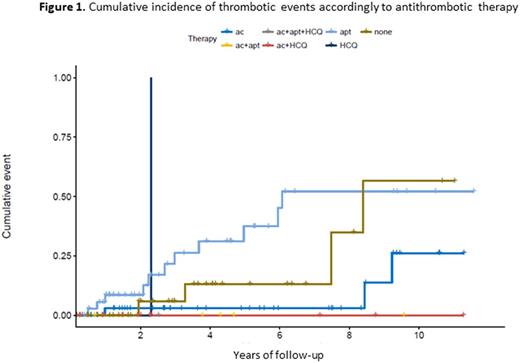Abstract
Background: There is marked heterogeneity in the clinical presentation of patients with antiphospholipid antibodies (aPL) and antiphospholipid syndrome (APS) and a variable thrombotic risk. Putative thrombotic risk factors include male gender, high titer aPL serology with IgG isotype, triple positivity and concomitant autoimmune disease. However, the evidence is conflicting for some, and the patient heterogeneity makes risk stratification challenging. Thus, long-term antithrombotic management decisions remain primarily driven by clinical judgment. Decisions such as discontinuation of therapy, use of direct oral anticoagulants (DOAC), and the role of hydroxychloroquine (HCQ) and immunosuppressive therapy remain areas of ongoing research.
Objectives: To outline clinical risk factors of thrombotic events in antiphospholipid patients and describe outcomes of different antithrombotic strategies in this heterogeneous cohort.
Methods: We retrospectively identified all adult patients followed at Weill Cornell Hematology with aPL or APS. Patients were included if they met laboratory criteria for APS. Data on patient demographics, concomitant thrombophilia, autoimmune disease, and family history of thrombosis, aPL isotype and titer, thrombotic events prior to and during follow-up, and antithrombotic therapies were collected. Time to event analysis was used to identify clinical risk factors for thrombosis. The time varying effects of antithrombotic therapies were also evaluated.
Results: A total of 122 patients were identified with a median age of 43 (range 19-86 yrs.). Ninety-three (76%) were female and 29 (24%) were male. Eighty-four patients (69%) were diagnosed with APS prior to their initial visit and the remaining 38 (31%) were aPL positive. Of the 84 APS patients, 63 (74%) had a history of a single thrombotic event and 22 (20%) had recurring events. Those were venous thromboembolic events (VTE) in 45 patients (53%), Arterial (AT) in 19 (22%), pregnancy morbidity (PM) in 12 (14%), and combinations of VTE, AT, and PM in the remaining 9 patients (11%). Of the 38 aPL positive carriers, 25 (66%) were asymptomatic, tested mainly for prolonged aPTT (68%), and 13 (44%) had non-criteria events that prompted testing. Autoimmune disease was present in 37 (30%), of which 16 (43%) were SLE. Hereditary thrombophilia was identified in 7 (6%) and a family history of thrombosis, aPL positivity, or APS was noted in 15 (12%).
During a median follow-up duration of 47 months, 19 patients had an event (16%). A significantly higher rate of thrombosis was observed in patients with autoimmune disease (HR 4.64, p<0.01), and in Blacks vs. Whites (HR 8.37 p<0.01). Triple positivity, found in 45 patients (37%), was not associated with an increased thrombotic risk. The risk of thrombosis was significantly lowest among patients on therapeutic dose anticoagulant therapy (ac) with low-molecular weight heparin (LMWH) or vitamin K antagonist (VKA) (Figure 1). In comparison, patients on antiplatelet therapy (apt) alone had 5.4 times the risk (HR 5.432, p=0.01). DOACs were used in 9 (10%) of the APS patients, with a median follow-up of 19 months (2-37) and a single event occurring in a young male without the aforementioned risk factors. Thirteen patients (11%) were on HCQ, 8 (7%) with autoimmune disease and 5 (4%) without, for a median duration of 20 months, with a single event occurring in a patient on HCQ alone.
Conclusions: In this study, concomitant autoimmune disease and Black race were risk factors for thrombotic events in antiphospholipid patients. Anticoagulation with LMWH or VKA remains the most effective therapy. Deciding on who can safely discontinue anticoagulation and who may benefit from additional antithrombotic and immunosuppressive therapies remains a matter of clinical judgment until multicenter, prospective studies are carried out.
No relevant conflicts of interest to declare.
Author notes
Asterisk with author names denotes non-ASH members.


This feature is available to Subscribers Only
Sign In or Create an Account Close Modal